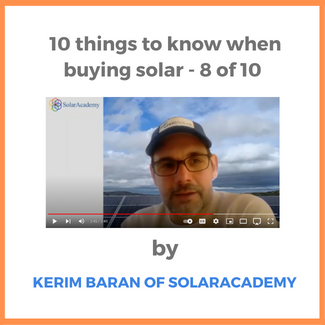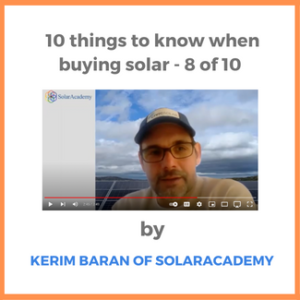In this eighth video in a ten-part training series of key concepts for people looking to buy a solar system, Kerim Baran of SolarAcademy lays out the three main options for paying for a solar array. The entire series can be viewed here.
Below is the transcript of the video:
Kerim Baran of SolarAcademy: We’ve talked about the economics and payback calculation in our last segment and, you know, depending on your location and your electricity price or the value that you’re getting for the electrons you create or the kilowatt-hours that the solar system creates, the payback calculation is what it is – might be three years, five years, seven years, ten years payback depending on the amount of sunshine the cost of the asset and the value of the electrons that flow out of the system depending on your location. But let’s just say it is in, like in most cases, that five, six-year payback or four, five six-year payback kind of asset, then the next question you have that you will be facing is whether you buy this asset right with cash and get your 26 percent federal investment tax credit or whether you’re gonna buy it with a loan.
Again the same tax benefit would apply but you would have to get a loan and apply for a loan, qualify for a loan and have monthly payments. Or you will have a third party owner handle that asset for you and you will lease that asset from them in which case all the tax credits would go to that third-party owner and you would be obligated to pay a monthly lease fee which ideally, as it is in most cases, will be less than what you were paying for that same amount of electricity to your local utility.
So those are the three most common ways solar systems are paid for whether outright cash, loan or lease. Another variation of a lease is called a Power Purchase Agreement. It’s pretty much the same thing with some slight variations – technical and legal variations – but overall pretty much it comes out to be the same thing. As at least as long as the asset is producing what it is supposed to produce. Technically you’re paying for each kilowatt hour and that’s why it’s called a Power Purchase Agreement. In normal situations, it works almost like a lease.
And then on the loan front there’s one other type of loan that I would like to talk about which is called a PACE loan – Property Assessed Clean Energy financing – is what PACE stands for. And this is a special kind of financing where the loan is taken on not by the individual applying for the loan but by the property itself. And the way that works is that the loan gets attached to the property rather than the person and the loan payments get paid along with the property’s tax bill. This is something that started about a year ago in California and is now in many other states besides California like Florida, Connecticut and probably more than a handful of other states. That is another very common way of financing solar loans or getting solar loans, I should say.
So that concludes our segment on whether to buy finance or lease your solar system. Thank you.


